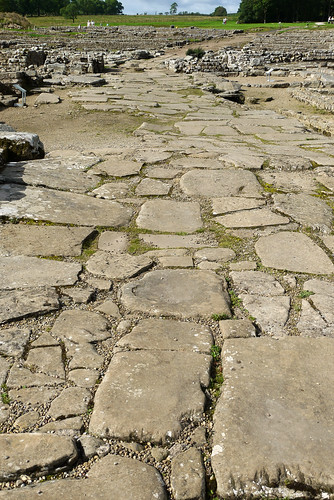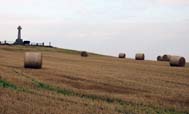Vindolanda lies just to the south of the curtain wall of Hadrian’s Wall and has a very different ‘feel’ to other sites along the Wall. It lies upon the first Roman frontier in the north – The Stanegate Road and in a stunning landscape which lets your imagination really connect with its past. You will probably visit Vindolanda by driving or walking along this road to reach the fort and museum. Although first built by the Roman army before Hadrian’s Wall Vindolanda became an important construction and garrison base for the Wall, a Hadrian’s Wall fort in its own right. During this time Vindolanda was demolished and completely re-built no fewer than nine times. Each re-build, each community, leaving their own distinctive mark on the landscape and archaeology of the site.
After Hadrian’s Wall and the Roman occupation was abandoned by its imperial armies Vindolanda remained in use for over 400 years before finally becoming abandoned in the 9th century.
The excavations at Vindolanda, set in its stunning landscape, aim to unravel the mysteries of its nine Roman forts/towns and countless communities. It is a huge and complicated task which is undertaken by a dedicated team of professionals leading a veritable army of volunteers. Come and see what the archaeologists discover, the excavations rarely disappoint, and continue to provide some of the most stunning examples of Roman and early British material culture to come from nine forts and nine centuries.
The physical remains include some of the following:
- A large Pre-Hadrianic bath house and a beautifully preserved 3rd century bath house.
- Several commanding officer’s residences and barrack buildings
- A headquarters building
- 3rd and 4th century evidence of village houses and workshops, latrines, and a Roman Celtic temple to an unknown Romano Celtic God.
- The only temple to be found on display to a Roman god inside an auxiliary fort anywhere in the Roman Empire (Jupiter Dolichenus).
- A Post-Roman mausoleum and late Roman Christian church Replicas of a Roman temple and shop, a Romano-British house and replica sections of Hadrian’s Wall in turf timber and stone
Added to all of this is the stunning Museum on the site, housing the cream of the Vindolanda Trusts collection from its on-going excavations. The collection includes the famous writing tablets (Roman post cards covered in ink handwriting), the finest collection of Roman footwear from the Roman Empire, textiles, pottery, militaria and personal items from the communities that lived there.














And now try to imagine all what has happened then and . . . since.
… and what will happen in times yet to come…
Ah, let’s not even try to think about …
I try to think about more enlightening things
These archaeology sites just blow my mind, Cherry. This one looks like a dandy.
You would really love this one. I can see you spending the whole day there
You would have had a field day climbing over all that.
I tried not to clamber over anything, but I did a lot of exploring
All these Roman sites blow me away. The culture they had in early times. I googled some more on the subject and saw some more pictures… amazing. I wonder how the ‘energy’ is there. Great pictures and are they still exploring the site like they do at the Roman Village at Chedworth?
Yes they are continually exploring this site and also expanding the area of exploration. It is fascinating. It is a long time since I have been to Chedworth it is time I went back for another visit.
It’s a fascinating place; the history of the area is incredible. I wonder what the Romans who were posted to northern England thought of their posting?
I am fairly sure that they wouldn’t have been too keen on the climate!!
Such a huge site!
Where did all the stones and bricks go?
Local church?
Not bad, people actually knew how to “upcycle” building materials back then. Ha!
Lots of Roman stones were reclaimed and used in other buildings. Pillars were used for font plinths and even gateposts.
A wonderful interesting post with some great photos. I so enjoyed learning all about the history. We’ve been to a few Roman forts and remains of houses but never to Hadrian’s wall area – hopefully one day
Hadrian’s Wall is well worth a visit. I am glad you enjoyed the post